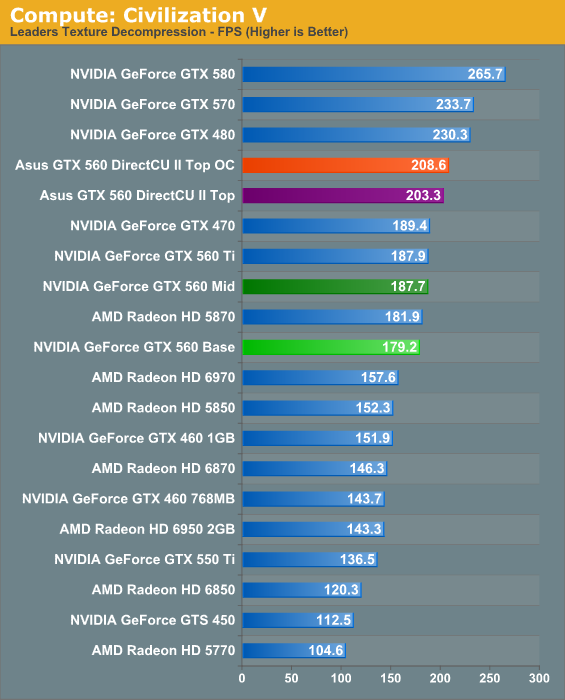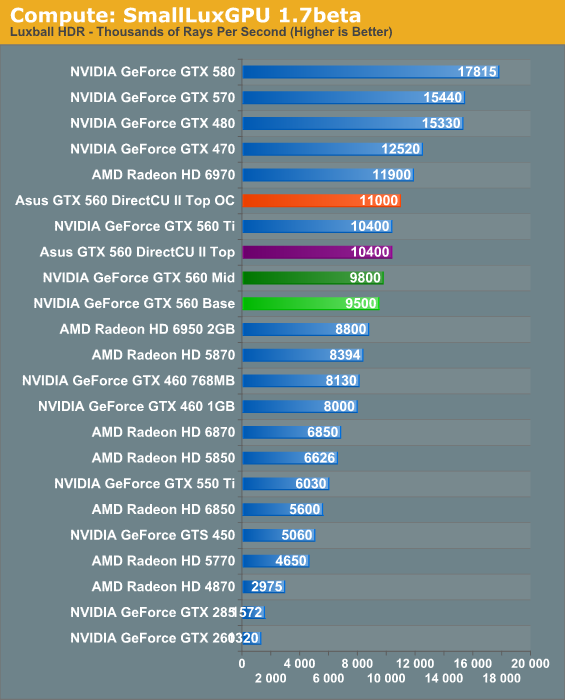NVIDIA's GeForce GTX 560: The Top To Bottom Factory Overclock
by Ryan Smith on May 17, 2011 9:00 AM ESTCompute Performance
Moving on from our look at gaming performance, we have our customary look at compute performance. Since compute performance is by definition shader bound, the GTX 560 is at a bit of a disadvantage here. Whereas the higher clocked ROPs would offset some of the GTX 560 Ti’s gaming lead, here the GTX 560 has nothing to stand on besides raw shader power.
Our first compute benchmark comes from Civilization V, which uses DirectCompute to decompress textures on the fly. Civ V includes a sub-benchmark that exclusively tests the speed of their texture decompression algorithm by repeatedly decompressing the textures required for one of the game’s leader scenes. Note that this is a DX11 DirectCompute benchmark.

This benchmark threw us for a bit of a loop, and we ended up running it several more times just to be sure. Under most circumstances the texture decompression test should be shader bound, but here it’s not – or at least not entirely. The GTX 560 Mid and GTX 560 Ti basically tie here, which is quite odd since the GTX 560 Ti has quite a shader advantage due to the 8th SM. As best as we can tell, either texture decompression doesn’t scale well with SMs, or it’s memory bandwidth bound at some point, with the latter case being the more likely of the two.
In any case as a result the GTX 560 Mid does quite well here, and the ASUS GTX 560 with its factory overclock shoots right past everything short of the 480/570/580. We’ll have to see if this weird outcome holds up in our other compute benchmark.
Our second compute benchmark of the day is SmallLuxGPU, the GPU ray tracing branch of the open source LuxRender renderer. While it’s still in beta, SmallLuxGPU recently hit a milestone by implementing a complete ray tracing engine in OpenCL, allowing them to fully offload the process to the GPU. It’s this ray tracing engine we’re testing.

Under SmallLuxGPU the GTX 560 behaves much more like we’d expect it to. The GTX 560 Mid does well, but it still falls behind the GTX 560 Ti as we’d expect. Keeping in mind that the theoretical difference should be around 10% in favor of the GTX 560 Ti however, the GTX 560 Mid still does a bit better than we were expecting, letting the GTX 560 take off with only a 6% lead. Compared to the GTX 460 however the difference is almost exactly what we’d expect it to be: the GTX 560 Mid is ahead by 23%.
Overall our compute results leave us a bit surprised: while extra shaders are normally extremely beneficial on compute benchmarks, that’s not entirely the case here. The GTX 560 series was never meant to be a compute powerhouse like the GTX 570/580, but if compute performance is a factor in your purchasing decision then it looks like you aren’t giving up much moving from a GTX 560 Ti to a GTX 560 Mid.










66 Comments
View All Comments
Grooveriding - Tuesday, May 17, 2011 - link
Would be nice to see a comparison of the 560 to the 460 both at the same clockspeeds.Looking at this review, they will perform exactly the same at the same clocks. But it would be nice to see the comparison none the less.
xxtypersxx - Tuesday, May 17, 2011 - link
I agree, it seems to be a pretty standard refresh except whereas 460's tend to top out around 850mhz, these make it much closer to 1ghz.I hope the all of the manufacturers learned their lesson from the rash of dying 460's a few months after launch and included heatsinks on the VRM's like Asus did. These GF114/GF104 cards draw too much current when overclocked for the manufacturer's to leave the mosfets naked as they did with most launch 460's.
I also liked how the clock scaling was presented in the review, this is a good way to handle the non-standardized speeds. I'm sure you'll get the standard comment whiners screaming bias, but at this point I'm convinced they will do this whenever you show an Nvidia card even power on correctly.
L. - Thursday, May 19, 2011 - link
I'm pretty sure they didn't learn too much, seeing what happened to tdp-control on the 590 ... (i.e. nerf the card else it's gonna blow up) - quite normal though, trying to put two 350 watt gpu's on the same board was a retarded idea, since it's not supposed to be a hairdryer.iGas - Sunday, July 10, 2011 - link
I agree.Would be nice to see a direct comparison clock for clock. And, perhaps a comparison with the 470, and 480 at base clock and OC.
PS. My MSI GTX 460, humming along perfectly at 940mhz (and it did broke into 1011mhz territory).
DarknRahl - Tuesday, May 17, 2011 - link
Larger resolutions would be handy.Stuka87 - Tuesday, May 17, 2011 - link
It would be interesting to see them tested on a 27" display, but most single card setups fall on their face at that resolution (2560 x 1440).L. - Thursday, May 19, 2011 - link
Well that's where you see AMD cards (2GB) get some more points.But as discussed .. makes more sense to have 2* 1080p instead, financially.
michaelheath - Tuesday, May 17, 2011 - link
Why? Nvidia pretty much said last week that the target market for the GTX560 was users who want an affordable card to play games at 1080p resolution. Who would buy a $200 graphics card to play on a $1000+ 2560 x 1440/1600 display anyway? If you have that much money in your pockets for a high-quality display, why would you skimp out on the graphics card?Ushio01 - Tuesday, May 17, 2011 - link
http://www.overclockers.co.uk/showproduct.php?prod...Only £440 ($660).
L. - Wednesday, May 18, 2011 - link
It is clearly dumb to think resolutions will stay at the same level for eleventy beelion years.Anyone who has a good monitor wants to make use of it and might want to know how it's going to work.
Besides, your 1000 bucks figure is like 3x the price for some of the cheapest 2560* .
And, 200 bucks is not exactly "skimping out" on the gfx ...